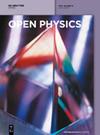带有半分离式倾斜梯形翼涡流发生器的板式散热器通道中的流动和传热数值研究
IF 1.8
4区 物理与天体物理
Q2 PHYSICS, MULTIDISCIPLINARY
引用次数: 0
摘要
为改善变压器板式散热器的散热性能,本研究对散热器空气侧封闭通道中的半分离式倾斜梯形翼涡流发生器(SDITW)的流动和传热特性进行了研究。将 SDITW 与倾斜三角翼(IDW)和倾斜梯形翼(ITW)通道进行了比较。分析了 SDITW 相对分离高度(e 1/e 2)、纵向间距(p l)、阻塞比(e/(0.5H))和倾角(α)的影响。首先,与 IDW 和 ITW 通道相比,SDITW 通道能产生稳定的角涡流,并且由于机翼的半分离结构,产生的横向涡流较弱,流动阻力较小。在 Re = 5,125-15,375 条件下,SDITW 通道的整体传热性能(性能评估标准;PEC)比 IDW 和 ITW 通道分别提高了 0.5-8.9% 和 1.7-4.9%。此外,在相同的 e/(0.5H) 和 α 条件下,随着 e 1/e 2 和 p l 的减小,SDITW 通道的努塞尔特数比和摩擦因数比都会增大。当 p l = 70 mm 时,SDITW 水道的整体传热性能相对较好。在相同的 e 1/e 2 和 p l 条件下,当 e/(0.5H) = 0.3(Re = 10,250 和 α = 30°-60°)时,SDITW 通道的 PEC 最大,整体传热性能最好。本文章由计算机程序翻译,如有差异,请以英文原文为准。
Numerical study of flow and heat transfer in the channel of panel-type radiator with semi-detached inclined trapezoidal wing vortex generators
To improve heat dissipation performance of panel-type radiator for transformer, this study investigated the flow and heat transfer characteristics of semi-detached inclined trapezoidal wing vortex generator (SDITW) in a closed channel on the air-side of the radiator. The SDITW was compared with the inclined delta wing (IDW) and inclined trapezoidal wing (ITW) channels. The effects of SDITW relative separation height (e 1 /e 2 ), longitudinal pitch (p l ), blockage ratio (e /(0.5H )), and inclination angle (α ) were analyzed. First, compared with the IDW and ITW channels, the SDITW channel generates stable corner vortices and produces weaker transverse vortices and lower flow resistance due to the semi-detached structure of the wing. For Re = 5,125–15,375, the overall heat transfer performance (performance evaluation criteria; PEC) of the SDITW channel increases by 0.5–8.9 and 1.7–4.9% as compared with IDW and ITW channels, respectively. Furthermore, for the same e /(0.5H ) and α , both the Nusselt number ratio and friction factor ratio of SDITW channel increase as e 1 /e 2 and p l decrease. For p l = 70 mm, the SDITW channel exhibits a relatively better overall heat transfer performance. For the same e 1 /e 2 and p l , the PEC of SDITW channel is maximum and the overall heat transfer performance is best when e /(0.5H ) = 0.3 at Re = 10,250 and α = 30°–60°.
求助全文
通过发布文献求助,成功后即可免费获取论文全文。
去求助
来源期刊

Open Physics
PHYSICS, MULTIDISCIPLINARY-
CiteScore
3.20
自引率
5.30%
发文量
82
审稿时长
18 weeks
期刊介绍:
Open Physics is a peer-reviewed, open access, electronic journal devoted to the publication of fundamental research results in all fields of physics. The journal provides the readers with free, instant, and permanent access to all content worldwide; and the authors with extensive promotion of published articles, long-time preservation, language-correction services, no space constraints and immediate publication. Our standard policy requires each paper to be reviewed by at least two Referees and the peer-review process is single-blind.
 求助内容:
求助内容: 应助结果提醒方式:
应助结果提醒方式:


